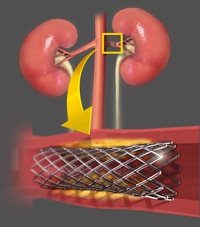Preventing Renal Artery Stenosis from getting worse
Treating high blood pressure that results from Renal Artery Stenosis
Relieving the blockage of the renal arteries
Angioplasty is a procedure in which a catheter is put into the renal artery, usually through the groin, just as in a conventional angiogram. In addition, for angioplasty, a tiny balloon at the end of the catheter can be inflated to flatten the plaque against the wall of the artery. Then your doctor may position a small mesh tube, called a stent, to keep plaque flattened and the artery open.
